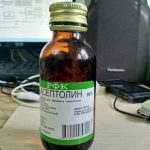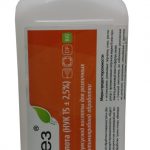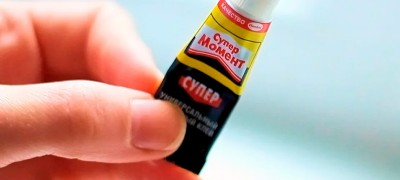How to clean a cooler at home
The modern environmental situation is gradually moving towards the state that if earlier devices for cooling and heating water (dispensers) were bought mainly by large companies, now such devices can be found even in a private house. In this regard, the issue of servicing such equipment becomes more and more urgent, since cleaning a water cooler is not a whim, but an urgent need, since, first of all, it is about health.

Causes of water pollution
The primary source of pollution can be water itself. Actually, that's why it is recommended to buy it only from trusted suppliers. The second most common cause is dirt and bacteria on the hands. If the neck of the bottle can still be protected with a protective film, then the ingress of microorganisms inside during its installation is inevitable. All this leads to their intensive reproduction, up to the appearance of colonies already inside the device - a characteristic coating is formed on the surface and, as a result, the cooler is cleaned.

In addition, the deterioration of water quality can be caused by the following factors:
- Lack of personal hygiene. No one can guarantee that all household members or employees in the office scrupulously adhere to basic sanitary rules!
- Unfavorable external environment. Dust in the room, lint from floor coverings, small particles contained on outerwear - all this sooner or later ends up inside the dispenser.
- Small insects and rodents. It sounds shocking, but it is a fact. Many public institutions where such devices are installed are at risk of spreading infections precisely because of the local "fauna".
- Scale build-up. Can indirectly cause damage to the cooling fan.

Important! It is highly recommended to wipe the water inlet needle with an antibacterial cloth before installing a new bottle!
Water cooler cleaning: subtleties and nuances
Before proceeding with self-processing, it must be borne in mind that this procedure requires the allocation of free space and takes quite a lot of time. Therefore, it is necessary to prepare in advance a clean bowl for rinsing "little things", a rag made of soft, lint-free cloth, a brush (or a clean toothbrush), a detergent (for a start, "Mister Muscle" will do as well). It is advisable to carry out this procedure in the intervals between replacing the container - this will reduce the likelihood of re-entry of bacteria inside.

Important! Never use abrasive cleaners, strong solvents such as acetone or benzine, or use dishwashers for cleaning and disinfection.
External sanitization
First of all, it is necessary to disconnect the dispenser from the electrical network, then remove the bottle and drain the water. Since disassembling the water cooler with your own hands does not imply any special difficulties, all external elements are subject to mandatory dismantling: the drip tray grill, decorative panels (if any), as well as the throat opening with a needle for supplying water.

All external surfaces should be thoroughly wiped with soapy water, to which you can add a little iodine or ammonia. In the latter case, it is advisable not to forget about the precautions. Thorough washing is required not only for the front - the back wall and even the power cord need to be thoroughly cleaned.
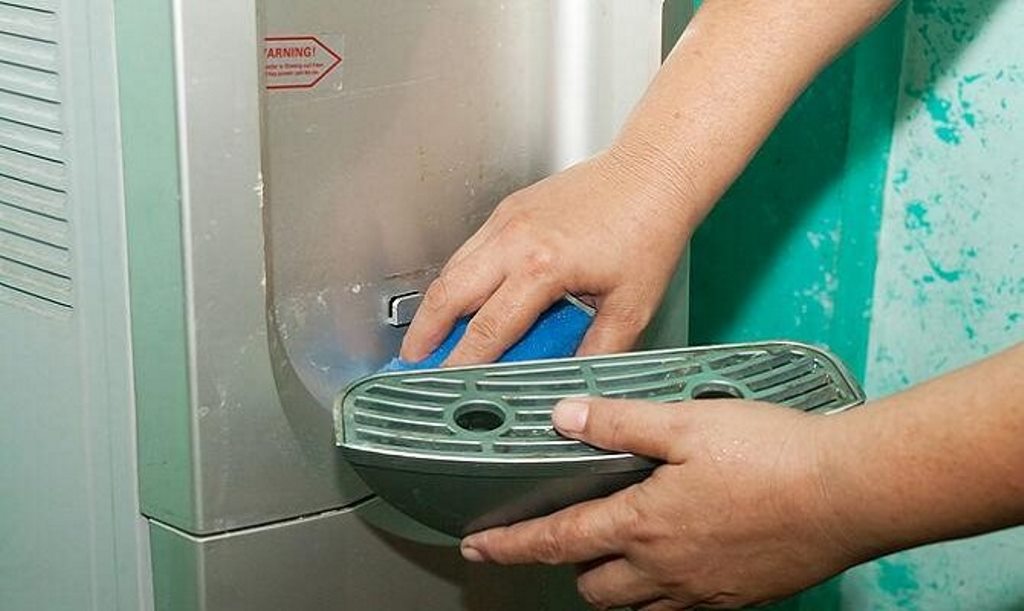
Additional Information! When draining water, it is necessary to strictly adhere to the specified sequence: first - hot water, then cold water, and finally - the remains through the drain plug.
Cooler cleaning: cleaning removable parts
All removed parts can be washed in a bowl of cleaning solution (or dishwashing detergent). In this case, before rinsing, it is necessary to thoroughly clean the formed plaque and accumulated dirt. For hard-to-reach places, it is better to use a special brush or toothbrush.

As an additional measure, you can spray a disinfectant solution on the removed parts and leave them there for 10-15 minutes. This procedure should be carried out after initial processing. In most cases, flushing a water cooler at home requires following a simple rule - it is better to put the cleaned parts separately.

Internal processing
Deep cleaning of the dispenser is carried out using a previously prepared solution. For this, both special products produced by the industry can be used, as well as the usual ones: vinegar or citric acid. Usually, a cooler is cleaned in two stages:
- Disinfection and descaling. The prepared solution is poured into storage tanks until they are completely filled. In this case, both taps are left open to remove air pockets and allow the cleaning fluid to fill all water supply channels and pipelines.

Remove the bottle receptacle - the device is unscrewed, and citric acid diluted with water is poured into the hole formed. - Washing. At this stage, thoroughly rinse all internal parts in contact with the solution. To do this, you need to make a clean spill with four times the volume of a standard 19-liter bottle. Despite the fact that flushing the water cooler at home requires a significant overrun, it is forbidden to use the city water supply as a source!

Pour part of the disinfectant solution into the water tank, leave it there for 10 minutes, then drain through the taps.
After that, you must turn on the dispenser and wait until the heating indicator goes out. Then, with an interval of 10 minutes, you need to drain a glass of water, alternately from each tap. The drained water is returned back to the cooler. The recommended duration of the entire procedure is about half an hour.
Additional cleaning
The final stage of cleaning is washing and disinfection of internal removable parts that are in direct contact with water: plastic pipes and lines, taps, separator, as well as all kinds of holders.
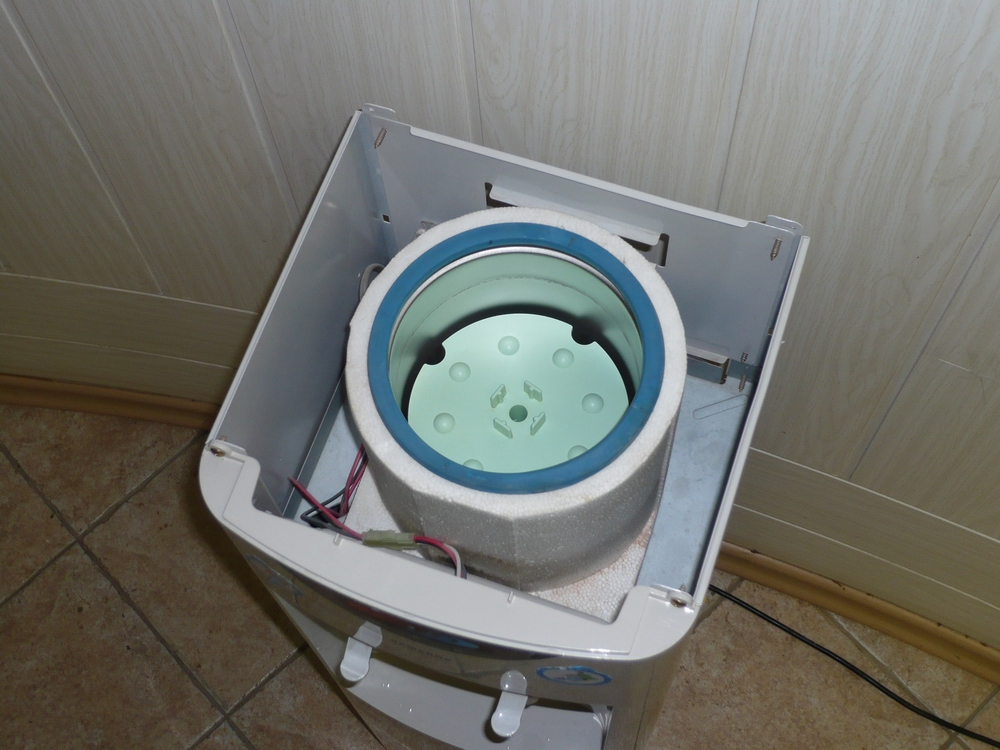
It should be remembered that some models of coolers allow the installation of taps with an internal thread - you need to be careful when dismantling them. Otherwise, cleaning is carried out using the surface cleaning method described above.

Flushing the water cooler at home: cleaning products
The easiest option is to use ammonia or iodine for disinfection. You can clean the inner surfaces of scale and plaque with citric acid (200 grams per standard bucket of water) or a solution of vinegar. In this case, after filling, the dispenser must stand for a long time, from 5 to 12 hours, depending on the degree of contamination.

As for special disinfectants, the most effective are "Aseptolin", "Cryodes", "Guanpolisept", "Bior-1". When removing scale, you can use the well-proven "Biolight N" or any other product suitable for cleaning teapots.
Water cooler cleaning: procedure frequency
If you follow the instructions, regular cleaning should be carried out every six months or, if the water consumption is more than 60 liters per month, once a quarter. Each time the dispenser is charged, it is necessary to disinfect not only the needle of the water inlet, but also the neck of the bottle, as well as the plastic stopper covering it. If the device is not used for more than a month, it must be completely cleaned without fail.

In addition, the need for monthly sanitization can be caused by the location of the cooler, for example, in industrial premises or in places with increased frequency of use: in a hospital or a store. In this case, on the back wall there must be a mandatory note on the date and volume of the procedure performed.

Cleaning the water cooler: why it is so important
The need to comply with sanitary standards when using a household cooler is primarily caused by a possible threat to the health of people who use it. If the drained water contains mechanical impurities, has a strange color or an unpleasant odor, this is a sure sign that it is time to clean the dispenser. In no case should you use such water! It can contain such dangerous bacteria as:
- Escherichia coli. It causes indigestion and often leads to body poisoning.
- Legionella. A pathogenic bacterium that has a negative effect on the gastrointestinal tract, nervous system and respiratory organs.
- Pseudomonas aeruginosa. It can cause pneumonia, osteomyelitis and, in some cases, meningitis.

Preventive actions
In order to prevent the development of pathogens inside the cooler and to keep the device in good working order and cleanliness, you should follow a few simple rules:
- Regularly flush the water cooler, both at home and with the assistance of special services.
- Decontaminate external surfaces periodically.
- Carry out systematic cleaning of taps and drip tray.
- Adhere to the rules of disinfection when changing the bottle.
- Observe the rules of personal hygiene.
Thus, keeping the dispenser clean and regular prophylaxis should not be regarded as a whim of the manufacturer or tyranny of the boss - the health of everyone who will use this device directly depends on this.Moreover, the water cooler should be cleaned as often as possible. Only in this state of affairs can you be sure that the water in the glass is clean, and the cooler is not a source of problems, but a real helper.

Video: how to clean a cooler outside and inside
